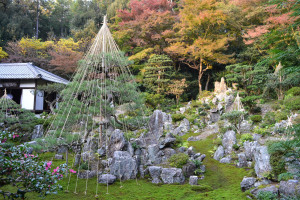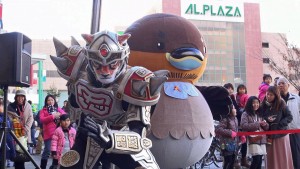Takashima: Where all Japanese Fans are Born
To most of the Western world, fans are an easily recognizable symbol of East Asia. Fans have been used in Japan for 100s of years and even used to be distributed by businesses as free gifts instead of the modern day free t-shirt. Specific cities in Japan have gained some renown for their particularly ornate and well crafted fans, one of which is Kyoto. However, in modern-day Japan, if a sensu (扇子) folding fan is advertised as made in Japan, it actually started its life in the small town of Adogawa, Takashima. Adogawa, Takashima, located on the west side of Lake Biwa, has nurtured a 300 year old tradition of crafting the ribs of the famous folding fans. In the early Meiji era a division-of-labor system was developed to produce fans quickly in the area. All of the artisans specialized in one specific part of the rib-making process and would live in the same neighborhood or on the same street. When they finished their portion of the fan they would run it over to their neighbor artisans. In this fashion they were able to mass produce fans. Long ago cities like Aichi used to also make the ribs of fans, but as fans have become less and less necessary in modern life, the production of fans has also decreased, leaving Takashima to produce 100% of Japan’s fan ribs. Because of this trend, the production of fans in Takashima has decreased from 1 million pieces a year to 600,000 pieces a year.

Fan ribs are traditionally made of Bamboo. From a cylinder of bamboo, the top green layer is sliced off and discarded, and then a thin layer of what’s left of the outer part of the bamboo cylinder is also sliced off and used to make the fan ribs. The outer layer of the bamboo is the hardest and the only section of the bamboo that can be used in the fan making process. Because bamboo from different regions varies in how soft it is based on humidity levels and other climate related factors, bamboo used for fans can only come from certain areas. Japanese bamboo is actually perfect for this task because the climate of Japan leads to strong sturdy bamboo that is still flexible enough for fans.

Using a variety of tools, the sliced layer of bamboo is turned into two different kinds of ribs: the naka-bone (lit. inner bone) which is the smaller thinner variety of rib that makes up most of the fan, and the oya-bone (lit. parent bone) which is the two larger ribs found on each end of the fan. Fans are actually valued by how many naka-bone are found in the fan because the more ribs there are, the better the fan feels and the harder it is to make. On average there are either 13, 33 or 43 naka-bones, but there can be up to 60. A fan with 60 naka-bones is very difficult to make because the artisan needs to make the ribs very thin and precise. There are very few people who can actually execute this process properly (the fan artisan at Suita Sensu, a shop in Adogawa, can make the 60-rib fan). We recorded the following video of Suita-san making the ribs into a uniform shape. In this video he has stacked 1300 ribs together and is smoothing them out with various tools.
After the ribs are formed they are dried in the sun for 4-7 days, depending on the season, until they turn the desired mustard color. They are then completed and sent to various cities, including Kyoto, to be decorated with painted washi (traditional Japanese paper).

There are many different kinds of fans which can be divided into three main categories: fans for daily use, which would be the smaller and simpler kind of fan, fans for dance performances which are more ornate than daily-use fans but must have the same pattern on both sides, and fans for decoration which are very elaborately decorated but usually only have a pattern on one side or a different pattern on each side. Fans used for decoration can also be used in traditional Japanese theatre performances like Kabuki and Noh. Each kind requires a different kind of rib. While the everyday fan is made up of thick rounded oya-bones and thin and slender naka-bones, fans meant for dancing, display, and theatre performances are composed of similarly thick oya- and naka-bones.

After shipping many of the ribs that have been produced to Kyoto and other large cities, some ribs remain in Takashima to be constructed and painted by local artisans. A variety of these fans can be found at the Adogawa Michi-no-eki (道の駅, or roadside station), called Fujiki-no-sato Adogawa 藤樹の里あどがわ (Map). This building hosts a small local market which sells a variety of food, including the local Ado berry, and crafts. A fan museum and workshop space (as shown in the top photo) is also located here . For more information, please follow this link: http://mitinoeki-adogawa.com/sensu.html
 From the left to the right, Suita-san: the owner of Suita Sensu, Murata-san: the executive director of Takashima Sensu Union, myself, and Belinda Kyle
From the left to the right, Suita-san: the owner of Suita Sensu, Murata-san: the executive director of Takashima Sensu Union, myself, and Belinda Kyle
Suita Sensu (Map) is another great place to find beautiful fans. Suita-san, the owner of the shop, is an expert in his field and makes incredibly beautiful fans. Recently this shop has been working with students from Seian University of Arts and Design (http://www.seian.ac.jp/) to create more modern versions of fans and pass on the tradition of fan making. Currently the students are working on a paper-free fan design. Suita Sensu and other shops located in Adogawa, Takashima are also working towards making 100% of their fans in Japan by using bamboo from local forests.
高島 -「メイドインジャパン」の扇子が生まれる町
多くの西洋人にとって、扇子は東アジアのシンボルとしてとらえられてきました。扇子は日本で数百年もの間使われており、また(欧米で)無料のPR用Tシャツが配られるのと同じように、粗品として商業的にも使用されてきました。手の込んだ美しい装飾で有名な扇子の産地は日本各地にあり、その例として京都があげられます。しかし、今現在「メイドインジャパン」と銘打って売られている扇子は、高島の小さな町、安曇川でうまれています。高島市安曇川は琵琶湖の西岸に位置し、(扇子の構造部分である)扇骨の生産地として300年にも続く伝統を育んできました。明治時代のはじめ、生産スピード向上のため分業生産のかたちが整えられ、それぞれの職人は扇骨を作る工程の一部のみを専門技術としていきました。職人同士で同じ通りや地域に居を構え、工程が終わると職人は次の職人へと工程を流していきました。この方法により扇子の大量生産が可能になりました。その昔、愛知県などでも扇骨は作られていましたが、現代の生活で扇子の使用が少なくなるにつれて消えていき、その結果、高島が扇骨の唯一の生産地としてシェア100%となるに至りました。しかし、この状況下では高島での生産も減り、一時は年100万本の生産数だったのが今では60万本までに落ち込みました。

扇骨は通常、竹を使用してつくられています。筒である状態からまず表面の緑の層が削り取られたあと、残った部分の一番上の薄い表面をスライスしたものが扇骨の材料となります。この層が一番硬い部分のため最適な素材となります。竹は(世界の)各地で生息していますが、湿気の度合いやその他気候が硬さに影響するため、扇子に使用する竹は特定の地域のものが使われます。高い湿度の気候で育つ日本の竹は硬さもしっかりあり、また扇骨に必要なしなり具合をもっているため最適だということです。

扇骨になる竹材を今度は、様々な道具を使い「中骨」と「親骨」という二種類の扇骨にしていきます。中骨は親骨より薄く、扇骨の大部分がこれにあたります。親骨は扇子の両端にある二つの大きな扇骨となります。扇子のグレードを見る一つの目安として、中骨の数が多いか少ないかがあります。中骨が多いもののほうが作りも難しいですし、実際に仰いでみたときの感覚も違います。通常は13本、33本、43本ですが、それ以上、60本程度も可能であるということです。しかし60本ともなると1本の中骨を非常に薄くする必要があり、限られた職人のみ作ることができるということでした。すいた扇子にて吹田さんが実際に扇骨を加工する工程を動画に収めました。1300枚もの扇骨をまとめた後、様々な道具により全体の表面がスムーズになっていく様子を見ることができます。
扇骨の形をつくったあと、季節によって違いますが4日から7日間程度、扇骨の色がからし色になるまで天日に干します。その工程が終わると京都などのその他の地域に送られ、そこで和紙などが貼られたのち装飾が施され完成品となります。

扇子には様々な種類があり、大まかに3つに分ける事ができます。サイズも小さく構造もシンプルな日常使い用、それに比べて装飾も派手で両側が同じ絵柄になっている舞踊用、そして非常に華美で片面だけに絵柄が施されていたり、裏表で違う絵柄がついているような装飾用の扇子となります。装飾用の扇子は日本の伝統芸能である歌舞伎や能でも使われているということです。それぞれの扇子で使用する扇骨のタイプは違っており、日常用では親骨が太く中骨が細い作りになっている一方で、舞踏や芸能で使用するものや装飾用では親骨と中骨のサイズにあまり違いはないということです。

この後、扇骨は京都やその他の地域にが大方送られ完成品となりますが、ここ高島でも扇子の組み立てや絵付けが行われています。それらは安曇川道の駅「藤樹の里あどがわ」 (地図)でも購入することができます。ここでは、アドベリーをはじめとしたこの地域の農産物や工芸品などが販売されています。また、扇子ギャラリー(トップ写真参照)やワークショップスペースも併設されています。詳しい情報はこちらで紹介されています。
 左から:すいた扇子吹田さん、滋賀県扇子工業協同組合専務理事村田さん、私、べリンダ
左から:すいた扇子吹田さん、滋賀県扇子工業協同組合専務理事村田さん、私、べリンダ
すいた扇子 (地図) でも様々な美しい扇子を購入することができます。このお店のオーナーである吹田さんは扇骨作りのエキスパートであり、素晴らしい扇子を沢山作られています。最近は成安造形大学の学生プロジェクトにおいて、現代的なデザインの扇子を作ることをなかで扇骨作りの伝統を継承する活動をされており、現在学生たちは扇骨だけでつくる扇子に取り組んでいる様子でした。また、高島にあるその他の工房も一緒になって、地元の竹材を使用した100%メイドインジャパンの扇子製造に向けて取り組まれています。


















Micaela
Elena, thank you so so much for this article. I m travelling in a month to Japan and had been looking for the "sensu capital" without luck. Do you know if there are any workshops that teach? I don't know Japanese (yet) but I would like to learn this craft and I m not sure how to proceed. Do you have any recommendation? I will definitely visit Takashima!